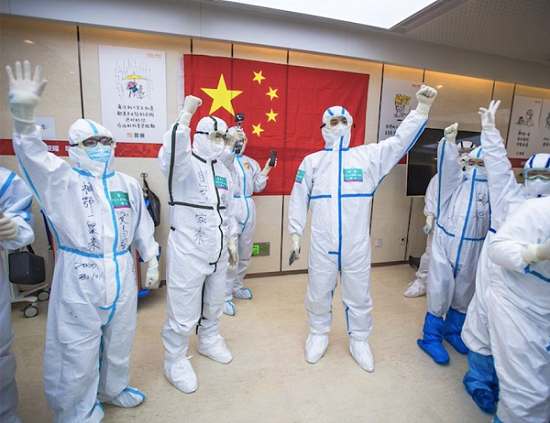Over 38,000 medical workers sent to Wuhan to fight virus

Medical workers from Hunan province and Guangxi Zhuang autonomous region sing songs together to celebrate the closing of the Wuchang Makeshift Hospital in Central China's Wuhan city on March 10, 2020. [Photo by Xiao Yijiu/Provided to en.nhc.gov.cn]
In response to arguably the worst health crisis the nation has ever faced, China mobilized an unprecedented medical force in its fight against the COVID-19 outbreak, sending over 38,000 medical workers to Wuhan alone, its hardest-hit city.
China began sending medical assistance teams to Hubei province, where Wuhan is located, as early as Jan 25 - the first day of the Chinese New Year.
As of March 1, China had in all sent 344 national medical teams to Hubei, including 17 teams of "traditional Chinese medicine" doctors and three military medical teams, to help control the outbreak.
The teams included 42,322 personnel, including 11,416 doctors and 28,679 nurses. Of them, 38,478 were sent to Wuhan alone.
The metropolis has a population of more than ten million. When it was locked down on Jan 23 to contain the outbreak, the city's medical staff were under tremendous pressure to treat the surging numbers of patients.
According to the Wuhan Municipal Health Commission, the city’s fever clinics saw 13,000 patients on Jan 22, a fourfold surge in merely four days. A day later, when the city was locked down, the number climbed to 14,486. For a week, it hovered above 10,000.
To make the situation worse, overwhelmed medical workers also faced a shortage of protective gear, as stockpiles quickly ran out.
As of Feb 11, Hubei province had reported 1,502 cases of medical workers infected with the virus, accounting for 87.5 percent of all infected medical staff in China, Zeng Yixin, vice minister of the National Health Commission, said at a press conference.
In Wuhan, 1,102 medical workers were infected.
The situation was so dire that the central government dispatched assistance teams from across the country to help Hubei, and Wuhan particularly.
The Beijing-based elite Peking Union Medical College Hospital rallied a team comprising 21 doctors and nurses within three hours of receiving the notice on the night of Jan 25.
They, along with 100 respiratory and infectious disease professionals selected from five other hospitals, formed the Beijing medical assistance team and arrived in Wuhan the next day.
In two weeks, the six hospitals would send a further 820 medical staff to Wuhan to relieve shortages of medical personnel there.
Wang Jianye, president of Beijing Hospital, said that the hospital deployed its best and most experienced doctors - specializing in respiratory and cardiovascular disease, intensive care and traditional Chinese medicine - to help combat the virus.
Northwest China's Ningxia Hui autonomous region dispatched, in six batches, 782 medical workers to Xiangyang, Hubei, another heavily-hit city about 350 kilometers from Wuhan.
The assistance team was so extensive that it accounted for half of Ningxia’s respiratory and infectious disease experts, intensive care and emergency medicine specialists, even though Ningxia faced its own challenges in combating the COVID-19 outbreak.
As the situation in Wuhan and around Hubei gradually became under control, the medical teams from across China began to conclude their missions in Hubei.
The first group of 41 medical rescue teams, some 3,675 medical workers and other personnel in total, departed from Wuhan back to their homes on March 17.
As of March 15, China's medical workers had helped 67,749 patients recover from the virus in all, with a cure rate of 83.3 percent. In Hubei, 55,094 patients had already recovered. 38,384 of them were in Wuhan.
- NHC minister visits Cuba
- NHC vice-minister meets with president of GE HealthCare
- NHC minister holds talks with WHO director-general via video link
- NHC minister meets with German health minister
- China to allow wholly foreign-owned hospitals in certain areas
- China's average life expectancy rises to 78.6 yrs


